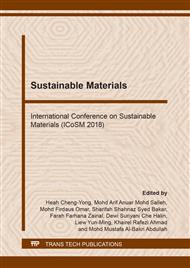p.284
p.294
p.301
p.308
p.315
p.323
p.330
p.335
p.340
Effect of Microwave Heating Variables on Nitrogen-Enriched Palm Shell Activated Carbon toward Efficient Hydrogen Sulfide Removal
Abstract:
This research work is focuses on understanding the characteristics of modified nitrogen-enriched palm shell activated carbon (N-PSAC) that undergo different microwave (MW) operating parameters towards efficient H2S removal. The nitrogen functional groups were tailored onto PSAC micropore structures through impregnation of urea onto palm shell activated carbon (PSAC). The effect of MW heating variables (heating temperature, N2 flow rate, heating time and amount of adsorbent) on N-PSAC adsorbent was investigated and analyzed with respect to H2S adsorption capacity.One factor at a time (OFAT) approach was used to produce an efficient N-PSAC adsorbent, where theH2S breakthrough capacity (measured at 5% of H2S outlet concentration) attained was in the range of 98.71 – 211.35 mg/g.It was found that MW heating variables contribute a significant impactto the modification of N-PSAC adsorbent in catering the H2S emission.
Info:
Periodical:
Pages:
315-322
Citation:
Online since:
August 2018
Keywords:
Price:
Сopyright:
© 2018 Trans Tech Publications Ltd. All Rights Reserved
Share:
Citation:


